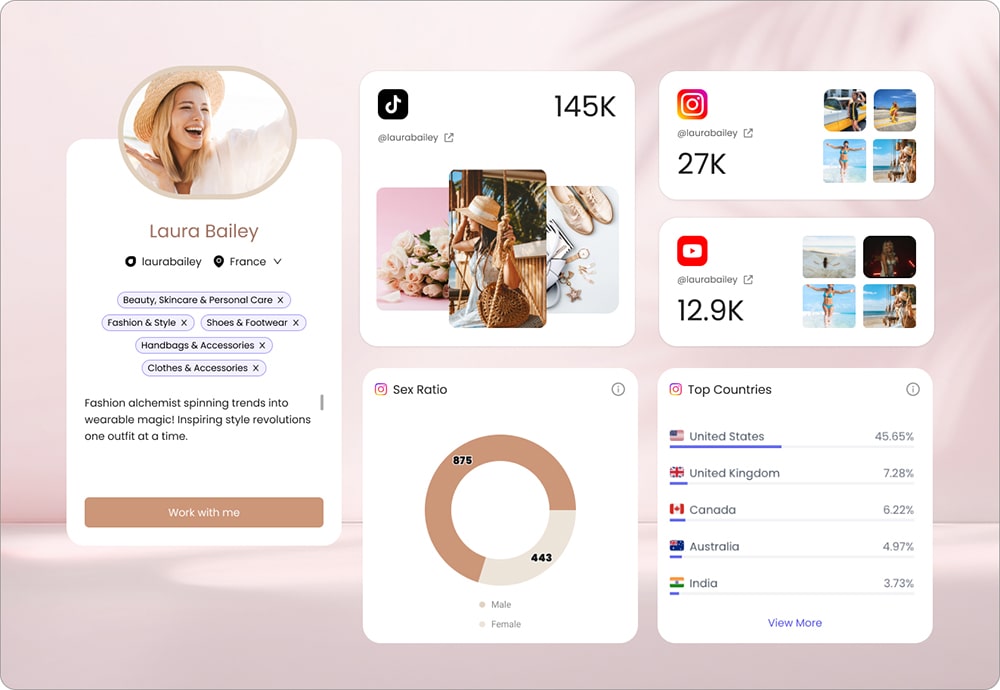Influencer marketing is a popular term in the marketing world today, and for a good reason: it’s an extraordinarily effective and rapidly growing marketing strategy. A study showed that in 2022 influencer marketing is set to reach $16.4 billion and 75% of brand marketers plan to include influencer marketing in this year’s strategy. However, the effectiveness of this method will largely depend on the strategy you build and adopt. In this article, we’ll discuss all the essential aspects of creating an effective influencer marketing strategy, from selecting the right influencers to measuring the success of your campaign. Let’s get started!
What Is Influencer Marketing Strategy?
In its simplest form, influencer marketing is a marketing technique when brands rely on influencers (people with a large social following) to promote their brand or product among their followers. Influencer marketing strategy, in its turn, is the strategy of leveraging that collaboration in a way that will yield the best result for all parties involved.
Developing an influencer marketing strategy is the cornerstone of every influencer marketing campaign. With the right strategy, you can choose and partner with the right individuals that will promote your brand, product, or your message among a targeted community through carefully curated messaging. Some of the benefits of taking the time to create a strategy are:
- Improved content strategy – it helps to fill the gaps in your content strategy in a meaningful and effective way
- Boosted brand awareness – the right strategy allows you to put your brand in front of the potentially interested people
- Trust towards the brand – influencers are trusted by their community, and so are the brands they promote, and working with the right creators can improve the credibility of your brand
- Improved sales and high ROI – Influencer marketing is one of the strategies with the highest ROI
Above all, an influencer marketing strategy gives you an idea of where to start your work, as well as how to navigate the process without getting lost.
Influencer Marketing Strategy Checklist
There is no right influencer marketing strategy since all brands have different needs and goals. However, there are several tried and tested steps you can take when working on your strategy to get started.
Identify Your Goals
The first step is identifying your goals. You need to be clear on what is it that you are trying to achieve with your influencer marketing efforts because depending on the goals, your actions, later on, will vary significantly. Some of the goals you’ll want to consider are
- Improving brand awareness among the potentially interested audience
- Building credibility and trust through collaboration with trusted voices
- Growing your existing audience by getting in front of new people in your niche
- Boosting the engagement of your social channels by getting views, likes, and comments
- Enhancing your sales pipeline
- Growing sales
- Improving your SEO through backlinks, primarily through working with bloggers
Influencer marketing goals are always business-specific, but chances are, you will be targeting one or more of these goals. Once you set specific goals, you’ll find it easier to remain consistent throughout your campaign.
Identify Your Audience

Once you’ve identified your goals, next is identifying your audience and your buyer persona. This is a step not to be missed because once you know a good understanding of your audience, you can make more informed decisions about your messaging and choice of creators.
If you’ve previously built user personas, or have a general idea of who your target audience is, it can be a great help at this step. For example, if you are producing skincare products, your target audience is likely people who are into skincare. That’s a start. From there, you can go on segmenting and breaking up your target audience. This segmentation can be done by:
- Interest – Separate groups differ from each other by their interests, and these interests are one of the key targeting methods.
- Age group – Sometimes, specific products ask for age-related targeting. For example, if you are producing children’s toys, you likely won’t be targeting teenagers.
- Location – Location is an important targeting factor, that can For example, if you are looking to get the word out there about your pop-up store, your target audience will be people living nearby.
Understanding your target market will help you build better relationships with them, even if it’s through the voice of the creators you work with, as you can develop messages and creatives that speak to their needs.
Research Potential Influencers
Next up is identifying the creators you want to cooperate with. The good news is, no matter the industry — gaming, technology, fashion, beauty, or fitness — there is someone out there passionate about it, who has been building an audience and establishing themselves as a credible voice in that niche. And these are the people you want to reach out to. From influencers on Instagram to YouTubers creating long-form videos to bloggers, there are many different options for you to choose from, depending on your needs. Typically, it’s more beneficial to work with an influencer who has an active presence on more than one channel, to maximize your exposure.
When it comes to the process of finding the right influencer, the strategies you implement can vary. You can search through hashtags or keywords or look through your competitors to understand who they are working with. What’s important to keep in mind is that when choosing a creator to cooperate with, it’s important that they are an authentic addition to your brand. They should match your brand voice, share similar values, and have aesthetics that work with yours.
Consider Your Budget
When it comes to budgeting, you should consider different ways of influencer remuneration. In most cases, you’ll be expected to pay a fixed rate to influencers, which will depend on influencer reach, the platform, the posting frequency, as well as the industry. Some of the factors that have an impact on influencer marketing costs include:
● Social media follower count, as well as the engagement rates
● The platforms used to promote the brand or product
● Frequency, as well as the type of content (static post, a story, a short video, a long-form video, etc)
● Products sent to the creators
● Other fees (e.g. working with an influencer marketing agency, costs for creating content, etc.)
For the influencer rates, there are more or less fixed industry averages you can go by. On Instagram, one of the biggest platforms for influencer marketing, the average rates per post are as follows:
● Nano influencers (1000 – 10,000 followers): $10 – $100 per post
● Micro-influencers (10,000 – 50,000 followers): $100 – $500 per post
● Mid-tier influencers (50,000 – 500,000 followers): $500 – $5,000 per post
● Macro influencers (500,000 – 1,000,000 followers): $5000 – $10,000 per post
● Mega influencers (1,000,000+ followers): $10,000+ per post
The budget you decide to set for your influencer marketing campaign will mainly depend on what you can allocate. Having a detailed budget as part of your strategy will help you to use that budget in the most effective way
Outreach influencers

How you will contact the influencers is one of the most important aspects of your overall strategy, and it shouldn’t be neglected. Most influencers have spent months or even years curating their audience, and they value the trust their followers put in them. So, they won’t work with brands that don’t align with their field of expertise or audience interests. What you need to do is have in mind what your cooperation will bring them, including and beyond the material reward, and how your cooperation can be beneficial for them and their audience.
As for the outreach itself, for nano and micro-influencers, you can usually contact them through direct messages. For larger creators, you may need to send an email, or contact them through their website, or through a designated PR person. More often than not the contact info will be available on their profile.
Create a contract with them
Work with influencers is work, and it should be documented. After the terms of your cooperation were defined and agreed on, it’s important to create an agreement to make sure that all obligations are met and both parties are protected. Additionally, depending on the country the cooperation takes place, an agreement can help to ensure the campaign meets certain legal requirements.
The influencer contracts you make will be tailored to each specific campaign, but some of the aspects most contracts will cover are:
- What type of content is needed
- What is the length of the campaign
- Who has creative control over produced content
- Who will check and approve the content
- Payment details
- Ownership information
- Other contract clauses, such as NDA, deliverables, contact information, etc.
You can significantly simplify the process by creating several contract versions for campaigns targeting different goals, and then updating them based on project details.
Use influencer marketing platforms
Influencer marketing consists of many steps and processes, from finding influencers to managing the campaign. For small teams of companies just starting with their influencer marketing efforts, the process can be time- and resource-consuming. Luckily, there are different influencer marketing platforms that you can use to simplify the process.
Influencer marketing platforms are websites and tools developed to act as a bridge connecting the influencer with the brand in a quicker and more straightforward way. There, you can announce the campaigns you want to run, listing what your requirements are. Influencers on the platform who look for cooperation will start reaching out. Alternatively, you can go through the catalogs of influencers, and reach out to those you think may be the right fit. You can then maintain the communication, campaign management, and monitoring, as well as the results review and payments directly on the platform.
Developing an engaging content strategy
The influencers you choose to work with play a critical role in the success of your influencer marketing campaigns, but so does the content you create. Therefore, it’s important that you take the time to develop an engaging content strategy and a good influencer marketing brief.
Here, what’s important to remember is that you want to make the campaign as attractive for the viewers as possible. It’s true that because they are in your niche, they are likely to be interested, but it’s no reason to stop there. Some of the methods you can use to make your campaigns more enticing are giveaways, affiliate marketing campaigns, discount codes, and campaigns about upcoming product releases—the opportunities are endless. If you are unsure where to start, one way to draw content inspiration is by taking a look at influencer marketing trends to see what is currently working well on the market, and adjust it to your brand needs. That said, it’s important that your campaign ideas emphasize what is in there for the potential customers, and how exactly they can benefit from your offer.
Tracking and analyzing results
The last step is understanding how the campaign performed by tracking and analyzing the results to understand if you should continue working with the same influencers or you should change your strategy. The first step is to see whether the campaign has reached its goals. A few KPIs (key performance indicators) you can consider are:
- Brand awareness – Website traffic and mentions
- Audience building – Social following, sign-ups, emails subscriptions, event registrations
- Social engagement – Likes, shares, comments
- Sales – Leads, new sales, event attendance
Track the data of each campaign attentively to understand what worked and what didn’t to adjust your next campaigns accordingly. For example, was a reel more engaging than a static post? Or did a dedicated landing page generate more leads than the homepage? Make sure to track all variables to have a clear idea of what drives the best results.
What are some of the best examples of influencer marketing?
Here are a few effective influencer marketing examples to help you get started with your influencer marketing efforts.
Itsjeanlum x Daniel Wellington
The jewelry and accessories brand Daniel Wellington worked with quite a few influencers, including Jean Lum to promote their Christmas and New Year deals. The aim of the campaign was to boost sales in Malaysia and Singapore both online and in stores through attractive holiday sales.
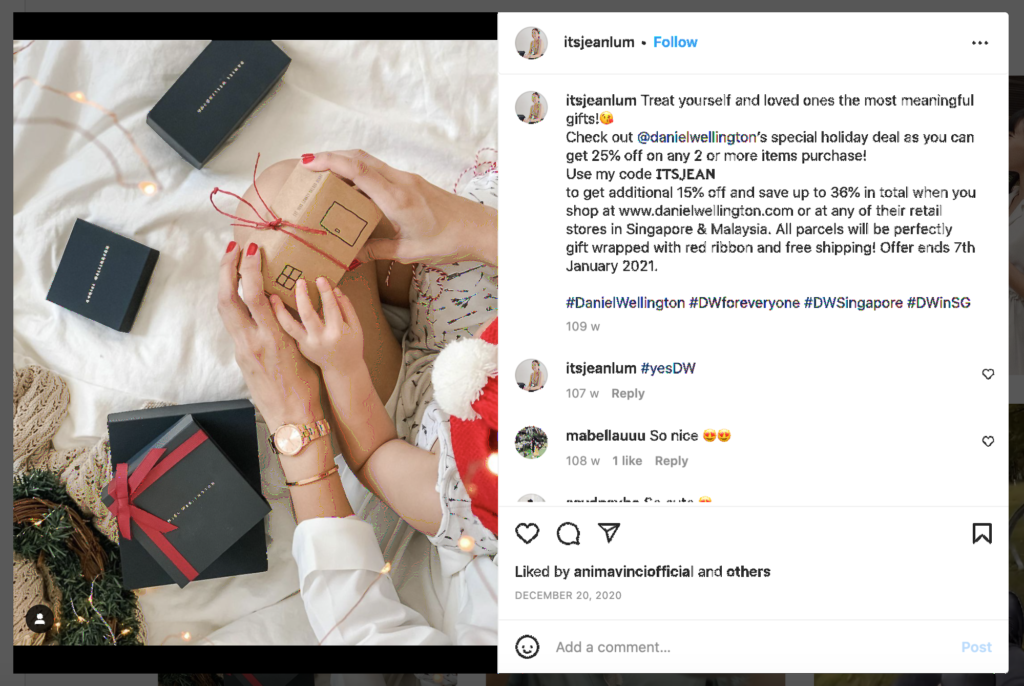
Melissackoh x Swarovski
Fashion blogger Melissa Celestine Koh (@melissackoh) was one of Swarovski’s influencers of choice for their Mother’s Day campaign. As part of the campaign, she pouted two photos. In the first one, she gifted her mother Swarovski earrings, and in the second one, the mother-daughter duo was wearing matching earrings, showing their followers that Swarovski jewelry can be an ideal gift for their mothers on mother’s day.
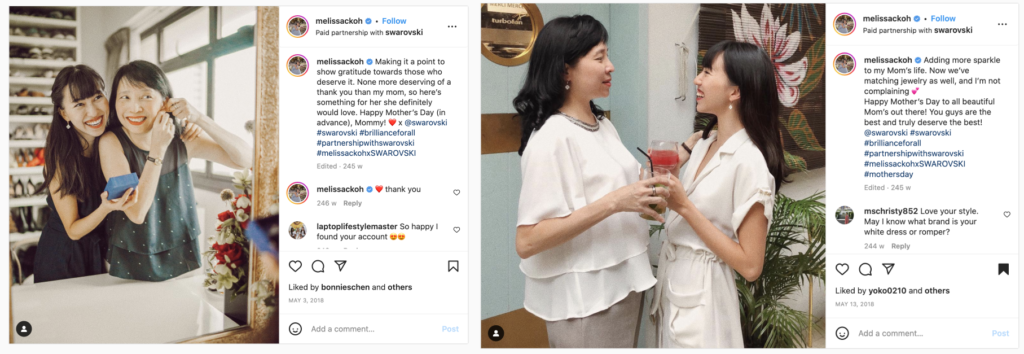
Lauramarano x BMW
As part of their #RoadToCoachella campaign, BMW enlisted a number of top influencers, including actress and singer Laura Marano. As part of the cooperation, influencers showcased BMW cars as their transportation means to the event. The campaign aimed to showcase different car models, and overall promote the luxury experience that is BMW.
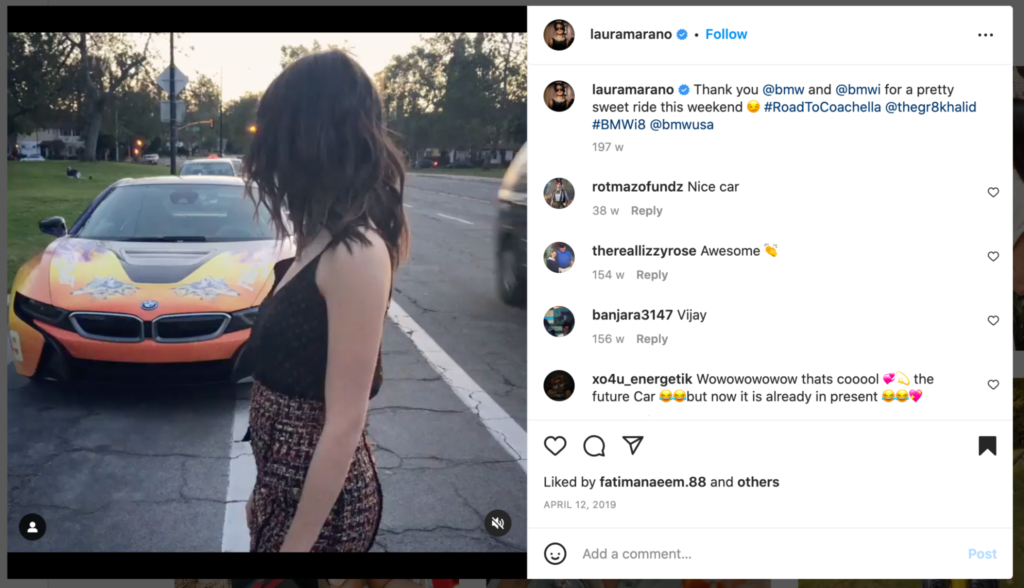
67 Shades of Dior
As part of the launch of their Dior Forever Foundation, which consisted of 67 different shades, Dior cooperated with the influencer marketing agency Buttermilk to enlist 67 influencers, each one matching one of Dior’s 67 shades. As part of the campaign, over the period of 67 days, each influencer made a post wearing one of the shades. The campaign aimed to showcase the wide variety of the product, as well as celebrate its diversity through ambassadors.
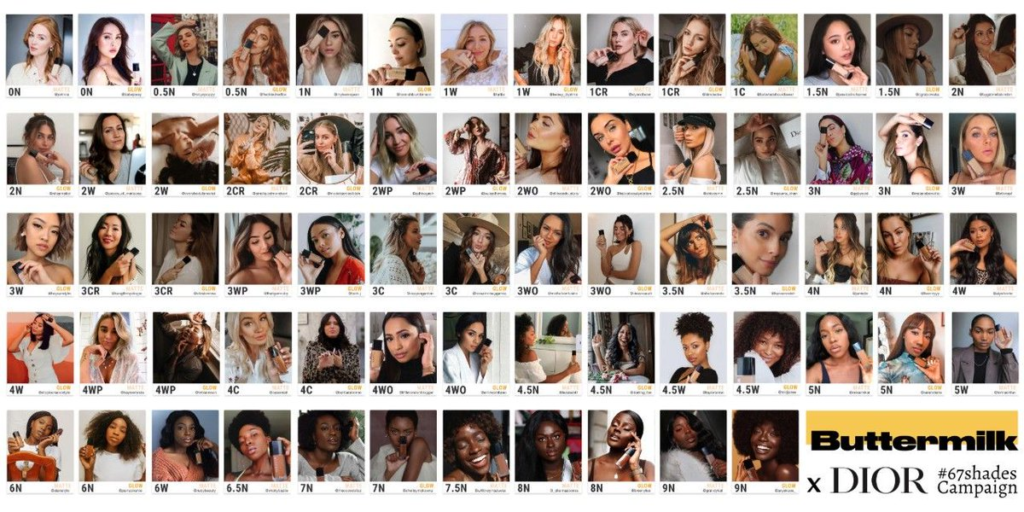
Conclusion
Once you’ve developed your influencer marketing strategy, you can start testing it to see what results it will bring. An effective and successful strategy will help you develop meaningful relationships with creators in your niche and reach your target audience on different platforms through the voices they trust.
A good influencer marketing strategy is the base of your efforts. However, keep in mind that influencer marketing changes rapidly, and the best strategies are the ones that evolve over time and adapt to change, and are flexible enough to scale and adapt to the future growth of your business and the industry.
Reviewed By Rem Darbinyan
Revolutionizing industries with AI, Rem Darbinyan is the CEO of ViralMango and an entrepreneur, AI expert, and influencer marketing strategist.

